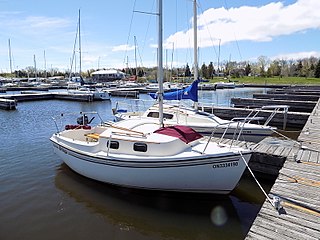Related Research Articles

The Buccaneer 18, also called the Buccaneer dinghy and the Gloucester 18, is an American planing sailing dinghy that was designed in 1966 by Rod Macalpine-Downie and Dick Gibbs as a one-design racer and day sailer. The prototype was first shown in 1967 at Yachting's "One of a Kind" Regatta, in which it placed second.
The Rhodes 19 is an American trailerable day sailer or sailing dinghy, that was designed by Philip Rhodes as a one-design racer and first built in 1958.

The Rob Roy 23 is an American trailerable sailboat, that was designed by Edward S. Brewer and first built in 1980. The design is out of production.

The Sanibel 18 is an American trailerable sailboat, that was designed by Charles Ludwig, first built in 1982 and named for the Floridian town and island.

The Halman 20 is a Canadian trailerable sailboat, that was first built in 1977.

The Mariner 19 is an American trailerable sailboat, that was designed by Philip Rhodes and first built in 1962.

The West Wight Potter 19 is an American trailerable sailboat that was designed by Herb Stewart as a cruiser and first built in 1971.
The Cape Cod Cat, also called the Cape Cod Cat 17 and the Hermann Cat, is an American trailerable sailboat that was designed by Charles Whittholz as a day sailer/cruiser and first built in 1968.
The Amphibi-Con 25, often just called the Amphibi-Con, is an American trailerable sailboat that was designed by E. Farnham Butler and Cyrus Hamlin as a racer-cruiser and first built in 1954. The design was one of the first "trailer sailers" and helped popularize this class of boat.
The Aquarius 21 is an American trailerable sailboat that was designed by Peter Barrett as a cruiser and first built in 1969.
The Com-Pac Sun Cat, also called the Com-Pac Sun Cat 17, is an American trailerable sailboat that was designed by Clark Mills as a pocket cruiser and first built in 2000.
The Coronado 23, also called the Sailcrafter 23, is an American trailerable sailboat that was designed by William Crealock as cruiser-racer and first built in 1969.
The Newport 17 is an American trailerable sailboat that was designed by Harry R. Sindle as a daysailer and first built in 1974.
The Irwin 23 is an American trailerable sailboat that was designed by Ted Irwin as a cruiser and first built in 1968.
The Eolia 25 is a French trailerable sailboat that was designed by Philippe Briand as a coastal cruiser and first built in 1983.
The La Paz 25 is an American trailerable sailboat that was designed by Lyle C. Hess as a motorsailer and first built in 1973.
The MacGregor 19, also called the PowerSailer 19, is an American trailerable sailboat that was designed by Roger MacGregor as a cruiser and first built in 1992.
The Mustang 22 is an American trailerable sailboat that was designed by Martin Bludworth as a Midget Ocean Racing Club racer and first built in 1969.
The Santana 2023 is a family of American trailerable sailboats that was designed by Steve Schock, with models for racing and cruising, first built in 1993.

The Sea Pearl 21 is an American trailerable sailboat or sailing dinghy, that was designed by Ron Johnson as a daysailer and first built in 1982.
References
- 1 2 3 4 5 6 McArthur, Bruce (2020). "West Wight Potter 15 sailboat". sailboatdata.com. Archived from the original on 11 August 2020. Retrieved 11 August 2020.
- ↑ McArthur, Bruce (2020). "Herb Stewart". sailboatdata.com. Archived from the original on 11 August 2020. Retrieved 11 August 2020.
- ↑ McArthur, Bruce (2020). "Stanley T. Smith". sailboatdata.com. Archived from the original on 11 August 2020. Retrieved 11 August 2020.
- 1 2 3 4 5 6 Sherwood, Richard M.: A Field Guide to Sailboats of North America, Second Edition, pages 52-53. Houghton Mifflin Company, 1994. ISBN 0-395-65239-1
- 1 2 3 4 Henkel, Steve: The Sailor's Book of Small Cruising Sailboats, page 64. International Marine/McGraw-Hill, 2010. ISBN 978-0-07-163652-0
- ↑ McArthur, Bruce (2020). "International Marine". sailboatdata.com. Archived from the original on 11 August 2020. Retrieved 11 August 2020.
- 1 2 3 4 5 International Marine (2004). "West Wight Potter 15". westwightpotter.com. Archived from the original on 11 August 2020. Retrieved 11 August 2020.
- ↑ "West Wight Potter 15". Sailrite. 2020. Archived from the original on 22 March 2022. Retrieved 11 August 2020.
- ↑ International Marine (2004). "West Wight Potter 15 Features". westwightpotter.com. Archived from the original on 11 August 2020. Retrieved 11 August 2020.
- ↑ McArthur, Bruce (2020). "West Wight Potter 15 Mk II sailboat". sailboatdata.com. Archived from the original on 11 August 2020. Retrieved 11 August 2020.